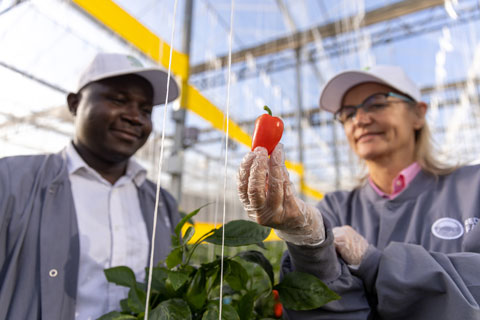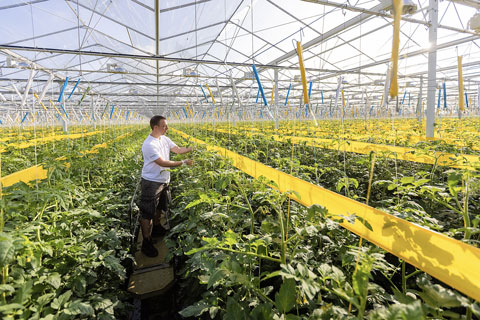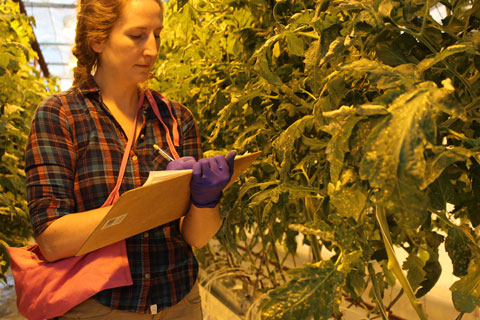2/1/2023
Breeding for Resilience
Jennifer Polanz

At virtually every controlled environment agriculture event I attended last year—whether it was a webinar, in person or online workshop—a familiar refrain connected all of them: breeding will be key in moving the needle on CEA.
That means identifying genetics of plants with ideal traits for indoor environments and crossing them with other elite genetics (for disease or pest resistance, for example) to achieve the perfect plants for the environment. The other key that was mentioned just as often was technology to make growing more efficient, which would go hand-in-hand with breeding for more productive plants in those environments. With companies working on both of these segments, the future is bright indeed.
Pictured: Peppers are one of the crops Red Sea Farms is breeding for resistance to salinity and heat.
However, (you know there’s always a however), there are challenges that have to be overcome before we get to that point and those challenges aren’t small. From financial constraints to the time needed to find the right genetics all the way to the vastly different environments CEA producers are using, there are many hurdles standing in the way of success.
Over the past couple of months, I’ve interviewed multiple industry members—including breeders, university researchers and growers—to get a nuanced look at the topic. In these pages, we’ll explore where we’re at right now, what those challenges are and what those industry members think we’ll see in the future.
The current state
The simple truth is very few of the genetics used currently in CEA growing are meant for indoors. Most of what we grow was first bred for outdoor field production, which means it’s specifically tuned for reduced pest and disease pressure unique to outdoors, as well as heat and/or cold tolerance and possibly drought-tolerance. Flavor is a factor, but often field production is focused more on yield, which leaves the CEA market an underutilized niche of producing high-quality, superior-tasting products.
Kevin Folta, professor and department chair of horticulture sciences at University of Florida, says he noticed a resistance to looking for new genetics early on in CEA.
“Years ago people just hated this idea. We’ve got everything we need, just use what’s already here,” he says. “I was a very unpopular guy for a long time. When we breed for the field what’s bred for Canada doesn’t work in Florida, and Florida strawberries don’t work in Canada.
“When we move to a completely artificial environment, we have to have genetics that fit that concept.”
Travis Banks, Director of Plant Variety Development at Vineland Research & Innovation Centre in Canada, says it became apparent that the field-grown genetics weren’t going to get CEA producers where they wanted to be.
“Like we’ve seen in our greenhouse tomato-breeding program, there are very successful producers, but with the right genetics, adapted for the region, adapted for the environment, then they could see even more profitability, which makes them more resilient as a business,” he said.
 Pictured: Tomato trialing at a Bayer Vegetable Seeds research greenhouse.
Pictured: Tomato trialing at a Bayer Vegetable Seeds research greenhouse.
There are some crops that are more primed for quicker gains than others, too. Tracy Lee Zogby, CEA Lead at Sakata Seed America, took my questions to her CEA team, and they said, “There is plenty of room for growth in crops like lettuce and spinach, as a lot of good genetics have been previously left to the wayside because they aren’t field-appropriate.”
That’s a good point that others made, too: there are lots of genetics out there that need a fresh look that were discarded from making crosses for field production. In other words, there could be genetics that are much better for controlled environments already out there.
Two of the leads at the R&D team for Bayer Vegetable Seeds, Mark Newell (Head of Solanaceous Produce Development Breeding) and Mourad Abdennadher (Americas Breeding and Testing Lead) also said lettuce and spinach are good CEA candidates for the near future. When looking a little longer term, they see more advancements in crops like melon, eggplants and strawberry.
“In general, crops that are most primed for CEA breeding, 1) Have the genetic variation available for long, extended pick cycles, and 2) Demonstrate added product quality when produced in CEA compared to open field,” they said.
Let’s talk traits
Before we get into those challenges, let’s talk about the traits that are ideal for CEA production. Of course, it depends on the crop, but there are some commonalities, as the CEA team at Sakata said.
“Some overarching themes are compact plant habit, early maturity, quick emergence and high yields,” Tracy relays from the team. “Another goal for light-sensitive crops is the development of varieties that are fast-growing, yet slow-bolting, which is difficult because those two things tend to be on the opposite ends of the same ‘stick’ when breeding.”
Meanwhile, Kevin notes that breeding for specific traits is primed to move faster than ever.
“The beauty of this is we have genomic-enabled breeding, where we can breed faster than we ever have before,” he says. “It really will be identifying the best parents with the best traits and using these genomics-based approaches to move quickly.”
He’s confident that we’ll see new varieties in the next few years in crops that move from seed to seed within weeks or months.
“Leafy greens will be the fastest because that is what people are already growing,” he adds. “Some herbs like basils and cilantros, too, and then once we have crops that are optimized, we have to optimize the light conditions they’re in to really accelerate them.”
On the basil side, PanAmerican Seed has been working for several years to adapt its downy mildew-resistant basil to what CEA producers would need, says Josh Kirschenbaum, Business & Portfolio Manager for vegetable sales.
“Flavor is super important—if a variety has the right growth habit and color, but doesn’t taste adequate, then often times growers will not choose that variety. So it has to have a nice flavor,” he adds. “The other main thing it has to have is the right plant habit. So often times, when basil is young or grown in CEA, as a young plant it can get leggy and stretchy with longer internodes.
“We’re also paying attention to the plant habit in CEA growing during our decision-making process.”
Currently, they have several lines they’re looking at and he hopes to have something commercially available in one to two years, with seed available for trialing now.
 Pictured: Jessica Pinder, senior research technician for vegetable breeding at Vineland Research & Innovation Centre, makes notes while observing breeding results.
Pictured: Jessica Pinder, senior research technician for vegetable breeding at Vineland Research & Innovation Centre, makes notes while observing breeding results.
Once traits like greater yield, habit and multiple fruit picks (in crops like tomatoes, peppers and cucumbers) are achieved, then we get into the consistent fruit quality in size, shape and color, say Mark and Mourad at Bayer. After that, aroma and flavor take precedence, then plant health to protect the yield and quality required by the grower.
One more aspect is to tune the genetics in to their environmental surroundings to optimize the growing conditions. Mark Tester, co-founder of Red Sea Farms and Professor of Plant Science at KAUST (King Abdullah University of Science & Technology), both in Saudi Arabia, says they’re working on breeding indoor crops to better tolerate heat and salinity stressors.
“Yes, we need disease resistance, we need robustness, we need fruit quality—we need a lot of different things,” he says. “Our little contribution is to try to increase into the germ plasm traits that are improving the ability of plants to tolerate abiotic stresses. Things like salinity and heat, and these are stressors that can be controlled in controlled environment agriculture, of course.
“You can argue, well, we’re in a controlled environment—we can just fix the temperature to 27 (Celsius) or whatever we need it to be and, of course, that takes energy. So if we don’t have to cool it to 27, if we could cool it to 29, that two degrees difference can lead to a pretty significant savings in the energy.”
Another example of this would be to select genetics for “plasticity” as Kevin says. “I think that one very popular option will be plants where you can change the product by changing the light. You turn on one program for a green leaf, a different program for purple.”
It’s just one part of a larger effort he’s been working on for a while. “Some varieties are just better at investing the photons you give them,” he says. “They take light energy and harvest it more efficiently. Identifying those varieties as a starting point is so important and that’s where our major efforts have been.
“We have some partnerships, but they’re all early in experimental and testing fringy ideas. They turn to me when they want to take a shot down the field.”
And while he says he is “cropnostic,” he likes to work with genetics that grow quickly on a small footprint, so he tends to work mostly with seedlings in identifying signatures in them.
“I can make predictions from the seedlings about how the adults will likely behave,” he adds.
The aforementioned challenges
There are many. To start, the investment in a breeding program can be substantial, both in time and money.
“One of the barriers is really critical mass to justify the investment in a breeding program,” says Travis from Vineland. “A breeding program typically takes seven-plus years before you start seeing the first improved varieties entering the market, and often breeding programs don’t tend to be a one-and-done sort of thing, right?
“You start the process of improvement, and so you’ll see your first release after seven years and then maybe you’ll see steady improvement coming out of that program every year or every couple of years from then on.”
Often, these efforts are a result of partnerships and collaborations, and everyone needs to understand the commitment level ahead of time, he adds. “If you decide after five years that it’s not for you, then you’ll likely not recoup that investment because you’ve gotten out before you have created your first product.”
Another major challenge for breeding companies and universities is the vast difference in growing facilities in CEA. From shipping containers to warehouse vertical farms and greenhouses, all of these environments play a role in how plants respond to their conditions.
“One of the biggest challenges is knowing what to breed for,” Tracy relays from her CEA team. “It has also been challenging to collect meaningful trial data to track our progress toward goals. As every system is so different, success with one grower does not translate to success with all CEA growers.”
There’s a learning curve, too, for breeders who are typically used to outdoor conditions (i.e., the vast majority of them). “Additionally for breeders, understanding diseases and growing behaviors of indoor crops/varieties that do not present the same as when that same crop/variety is grown outdoors. This requires a lot of diverse-system trialing to figure out most important traits on which to focus,” she says of her team’s assessment.
Travis also notes that breeding has historically been more reactive than proactive in response to some new pest or disease. While that breeding is absolutely necessary (think of the breeding for resistance to Tomato Brown Rugose Fruit Virus happening now, for instance), controlled environment efforts largely need to be more strategic.
“We see that this is the direction food production is going, and so as we adopt CEA technologies (and) production systems, we should be moving along and developing the varieties for those systems,” he says. “You have to figure out how to grow a crop before you can start breeding a crop. You wouldn’t want it to be reactive because then you’re waiting for the problems to pop up, when really it could be you’re breeding for opportunity.”
Yet another challenge is the length of the plant’s life cycle that CEA requires.
“One of the primary challenges facing breeding for CEA crops is the longevity of the cycle and maintaining the desired quality standards of the consumer,” say Mark and Mourad at Bayer of certain crops that require multiple fruit picks. “However, the long crop cycle presents many opportunities to collect more data and utilize that data to make better selections during breeding.”
The future of CEA breeding
Mark at Red Sea is optimistic about the future, particularly in one area of breeding they’re working on heavily.
“Our particular company, we see fantastic opportunities because it’s often economically viable to graft, and you can get quite good returns from grafting, which means really you can have two different breeding programs, and in that commercial individual plant you can have four genomes all contributing to that production of your produce, and that—to me—is fabulously powerful.”
The conditions they’re working under are by no means ideal, either, with extreme temperatures and humidity, even during the night hours where plants really need to cool off.
“It’s extreme here, so if we can get something to work here, we can get it to work anywhere,” he adds.
Travis at Vineland thinks the future in CEA will be crops adapted more for local environments, since that will drive efficiency at those production facilities.
“The crops we’re growing now won’t necessarily be adapted to the climate in 20 years, so to have a secure food system we’re going to need to work on it now,” he notes. “To buy locally and reduce the carbon footprint of ag and drive more local production, there will be more need for locally adapted genetics.
“So I think breakthroughs with crops will be driven at the grower level, with research institutions like ours and for-profit companies going in and supporting entries into these new crops.”
He also says investment will be a key. “I think you’ll see large companies where they have more money to invest in R&D, I think that’s where you could see transformational changes, so new cropping systems to work with automation, for example. We know industry is going toward automation; I think you’ll likely see these larger companies developing the first varieties that are specifically tuned for some of these larger automation systems.”
The future of CEA likely won’t just be the crops we see now, too, as breeding allows for more variety.
“Almost anything could become an indoor crop,” says the CEA team at Sakata. “It is just about developing the market. If you think about Japan’s elite, high-dollar fruit market, CEA would be a perfect fit for something like that. Berries beyond strawberries would probably be a consumer win.”
That wasn’t the first time berries came up, either. When talking about other crops that could be “primed” for CEA production with some breeding help, other berries like blackberries and blueberries came up, as well as melons (which are currently already being done by Pure Flavor).
“I would never say something is not amenable,” says Kevin at University of Florida. “I think creative innovation can make anything possible. The problem is we don’t have the funding for really good, basic ideas, so me staring at the ceiling late at night coming up with really edgy stuff—I don’t put too much energy into it, but anything can be done.
“With the amount of money in this space, I think so much can be done, but it is being spent on everybody doing the same thing.”
In the end, the breakthroughs will likely come from a combination of for-profit breeding companies, university efforts and growers, say Mark and Mourad.
“Some of the more successful and unique products that are sold today have been incubated in a relationship between any two or all three of these groups,” they said. “It certainly takes these groups to work closely to deliver a product that is successful and meets the needs of the consumer.”